Mango chiffon cake is light and tender, frosted with the most delicate mango whipped cream, and filled with creamy mango curd. Use the season’s best mangoes for the ultimate summer treat or use frozen mangoes so you can enjoy this delightful cake all year.
(Love mango desserts? Try mango bars and mango mousse. So good!)
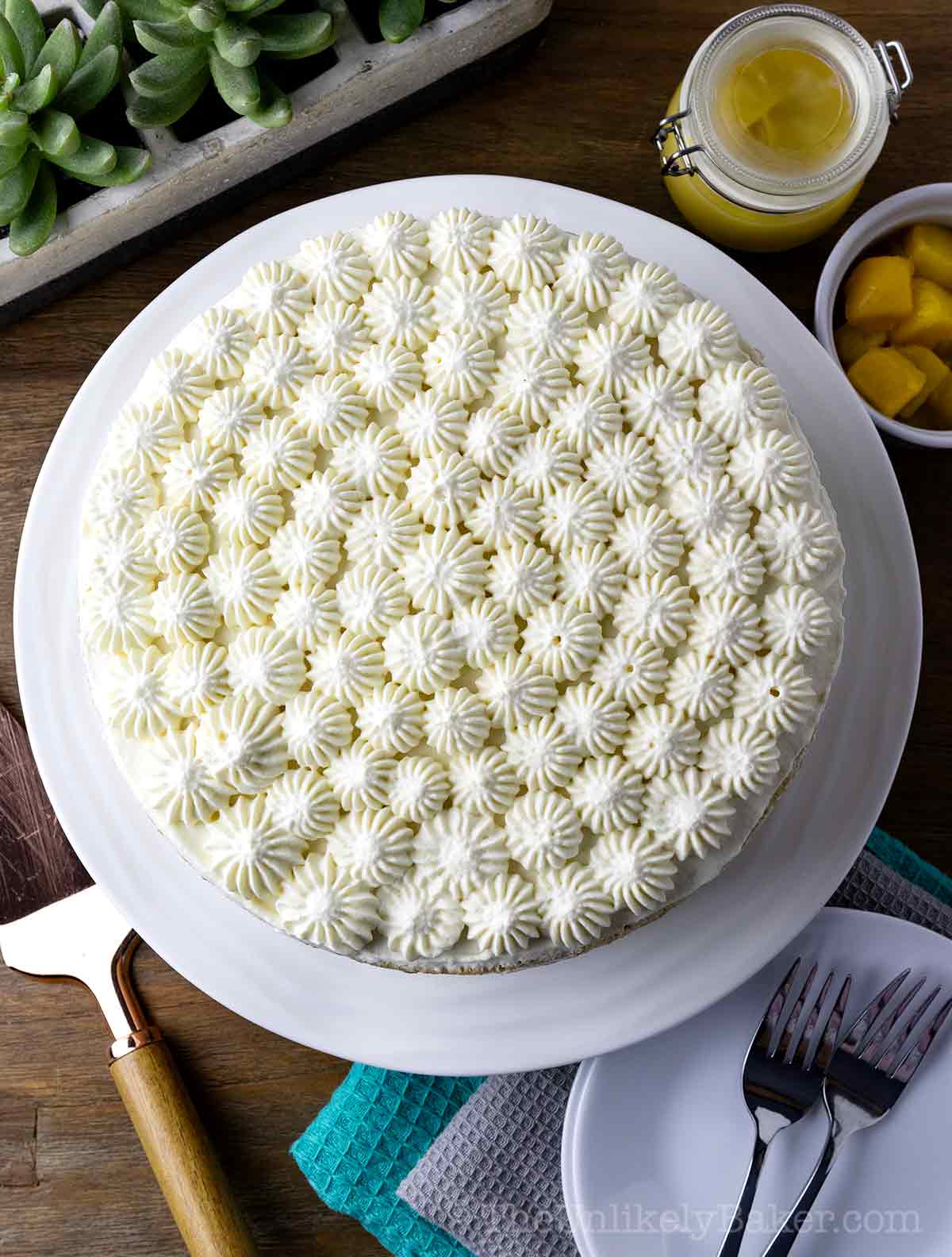
Mangoes are one of my favorite summer fruits and mango chiffon cake is one of my favorite desserts to make with them.
Let’s get to it.
Why you’ll love this Filipino mango cake

- Soft and tender. The sponge cake layers are so soft and tender, a joy to eat!
- Airy frosting. And they are complemented by an equally light and airy mango frosting made of whipped cream and mango puree.
- Mango is the star. Mangoes have a subtle flavor but it shines through here.
- Tastes better homemade. If you’re a fan of the chiffon mango cakes from Red Ribbon and Goldilocks, dare I say you might find this homemade cake better!
Ingredients and baking tools
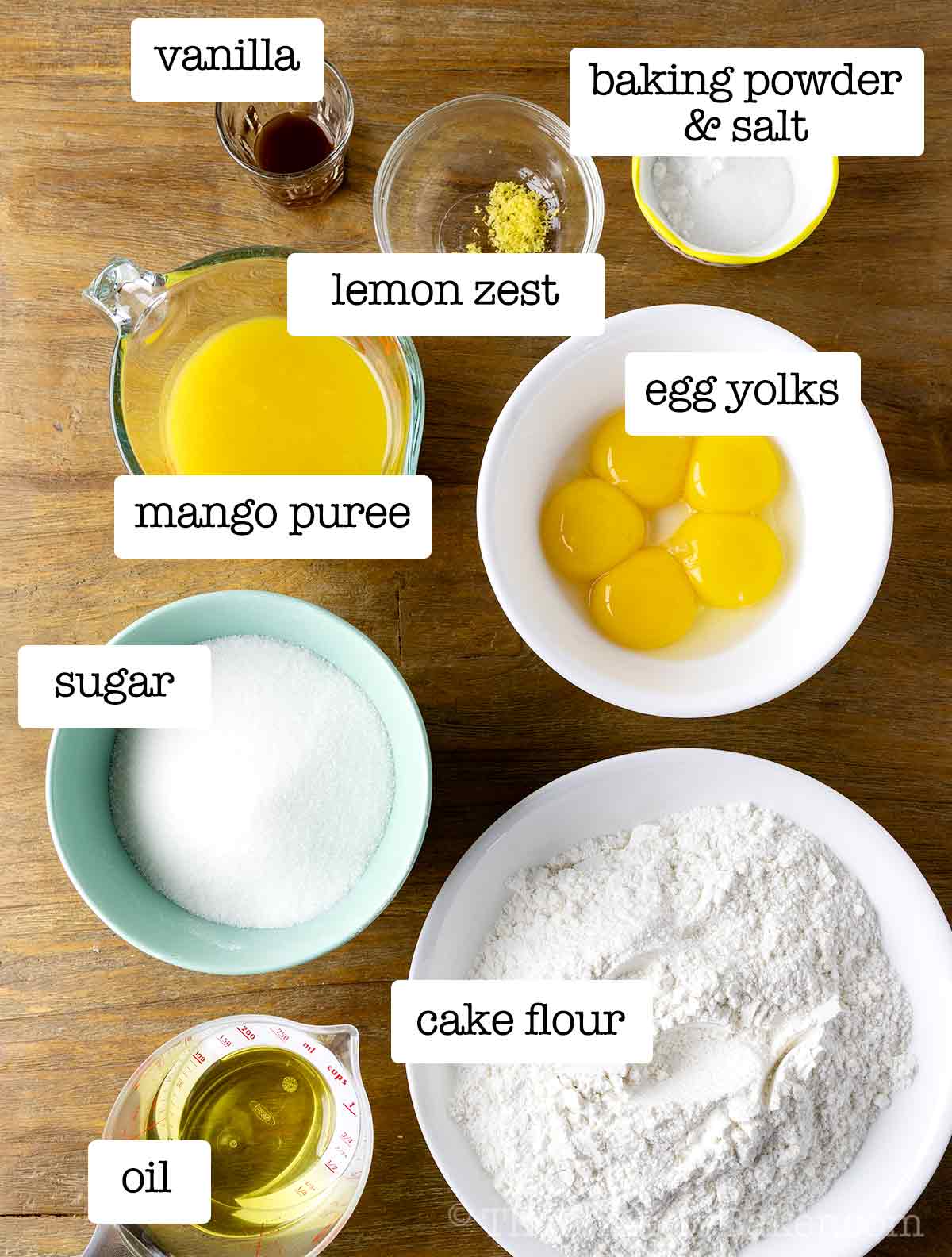
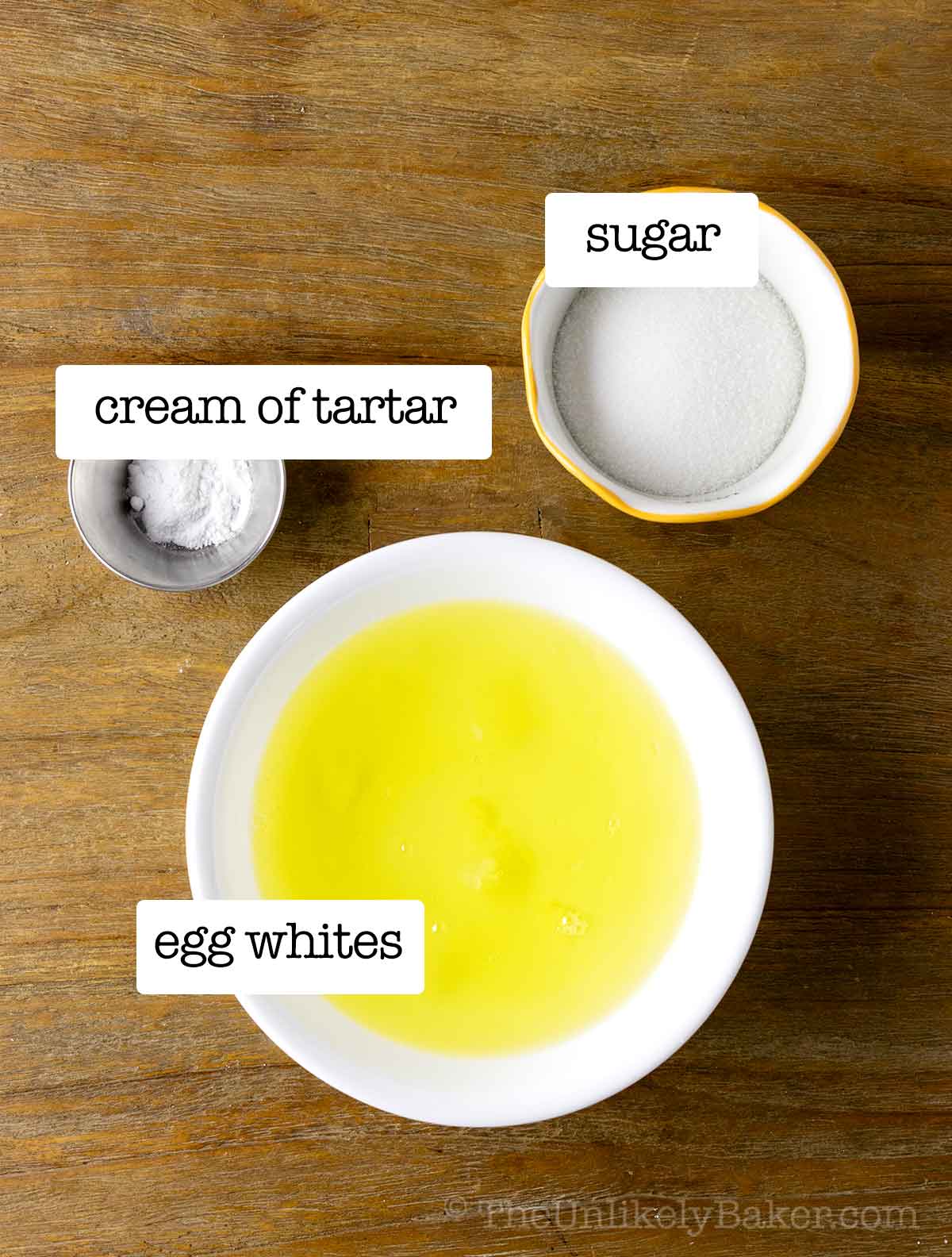
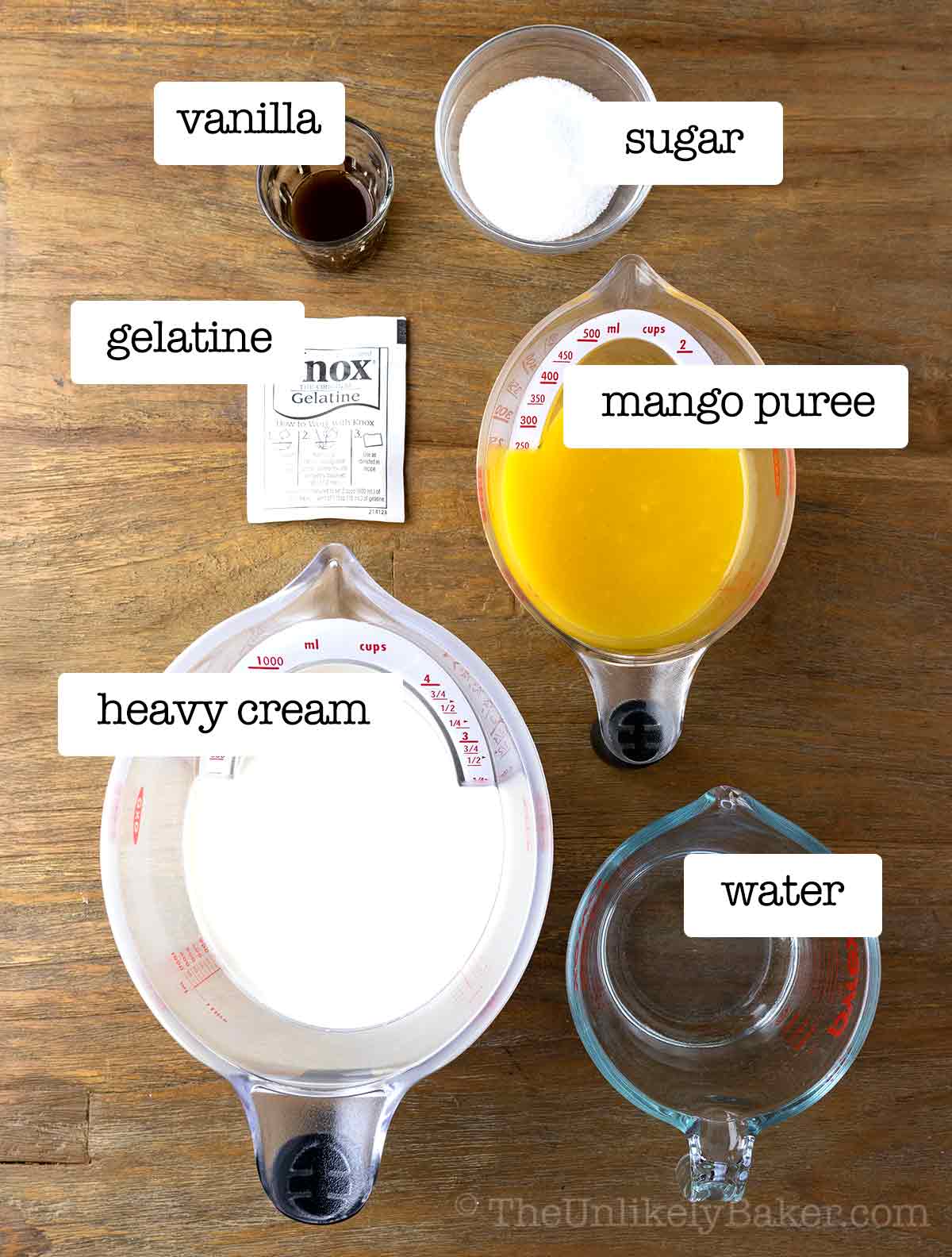
There are three components to this cake: the cake layers, the frosting and the filling.
Don’t be intimidated by the number of steps though; I break down each one into manageable parts that’s easy and simple to follow.
Ingredients
You’ll need pantry staples like granulated sugar, baking powder, and vanilla extract. Scroll to the bottom of the post to find the full ingredient list.
A few things to note:
- Cake flour — this helps give the cake that soft and tender crumb. If you don’t have cake flour, you can easily make your own by mixing all purpose flour and cornstarch.
- Canola oil — this is what I use because this is what we use for cooking. But you can use any flavorless oil like vegetable oil.
- Eggs — we use large eggs in this recipe, which we separate. To make it easier, separate the yolks from the whites while they’re still cold then leave on the counter so they can come to room temperature.
- Cream of tartar — this is what helps stabilize the egg whites and what helps us get stiff peaks. I alway use cream of tartar but if you don’t have it, you can use 1 teaspoon of vinegar or lemon juice for every ½ teaspoon of cream of tartar in the recipe.
- Heavy cream — this is called differently in different countries but for best results, choose cream that has milk fat content between 36 and 40%. If not available, whipping cream (35%) will also work in a pinch.
- Mango puree — I usually use store-bought mango puree. You want to make sure it’s pure mango and doesn’t have added sugar or other ingredients. If using fresh ripe mangoes, you can use your blender or food processor to puree the mango flesh then strain to remove any fibers left behind.
- Mango curd — I make mango curd and use that for filling the cakes. Alternatively, you can use fresh ripe mango slices, or even mango marmalade.
Baking tools
You’ll need 3 9-inch round cake pans. Alternatively, you can use 3 8-inch square pans. You can find more information on pan substitutions here.
I also like using my stand mixer when making the meringue, but an electric handheld mixer will work too.
Step-by-step photos
Mango chiffon cake
Pre-heat your oven to 325F and line the bottom of 3 9-inch round pans with parchment paper. Do not grease.
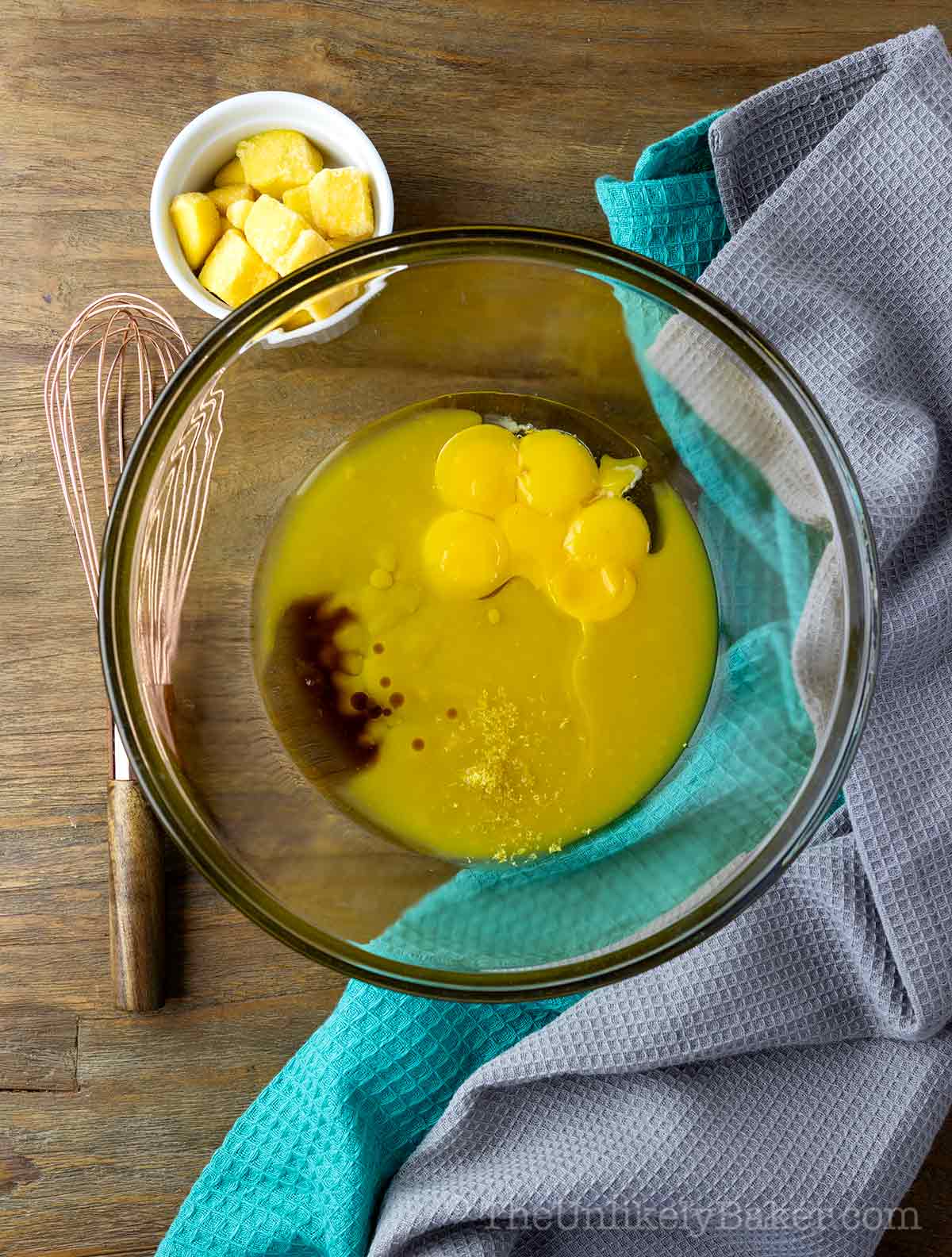
Using a handheld electric mixer or a stand mixer with the paddle attachment, beat egg yolks, mango puree, canola oil, lemon zest and vanilla extract on high speed until incorporated (about a minute).
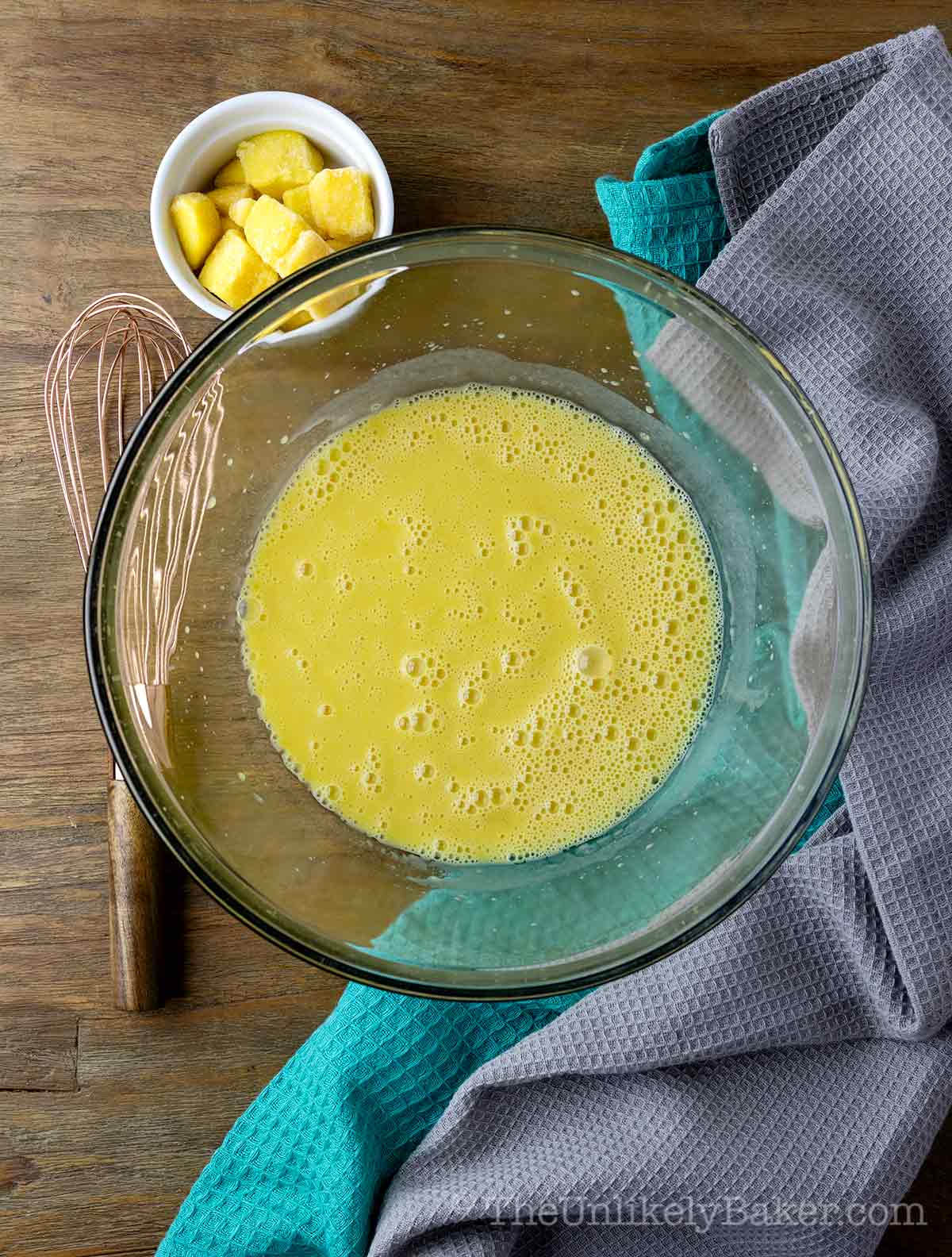
Set aside.
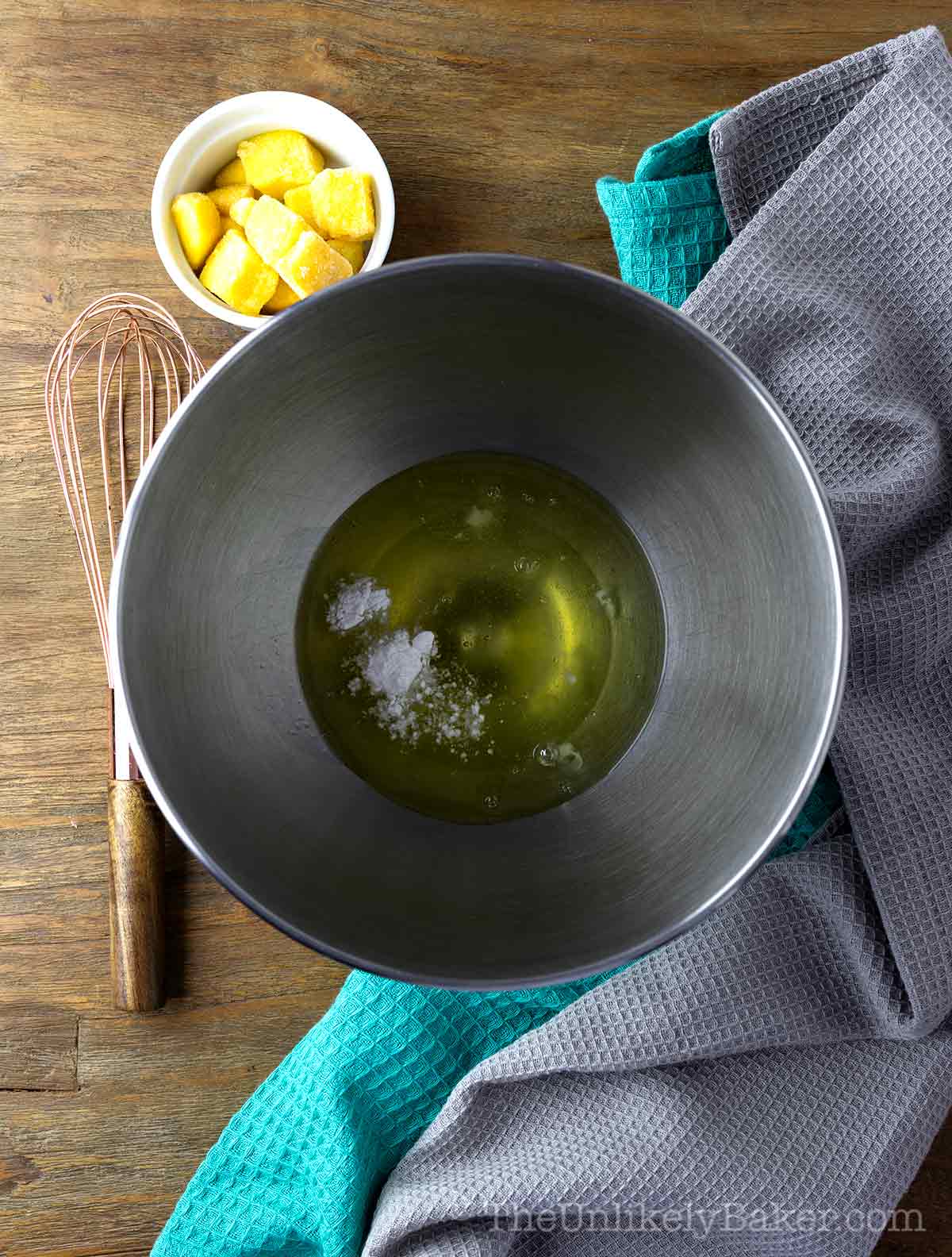
Using a handheld electric mixer or a stand mixer with the whisk attachment (if using the same mixers, ensure they are clean, dry and grease-free), beat egg whites and cream of tartar on low-medium speed until you reach soft peaks.

This takes me about 1-2 minutes.
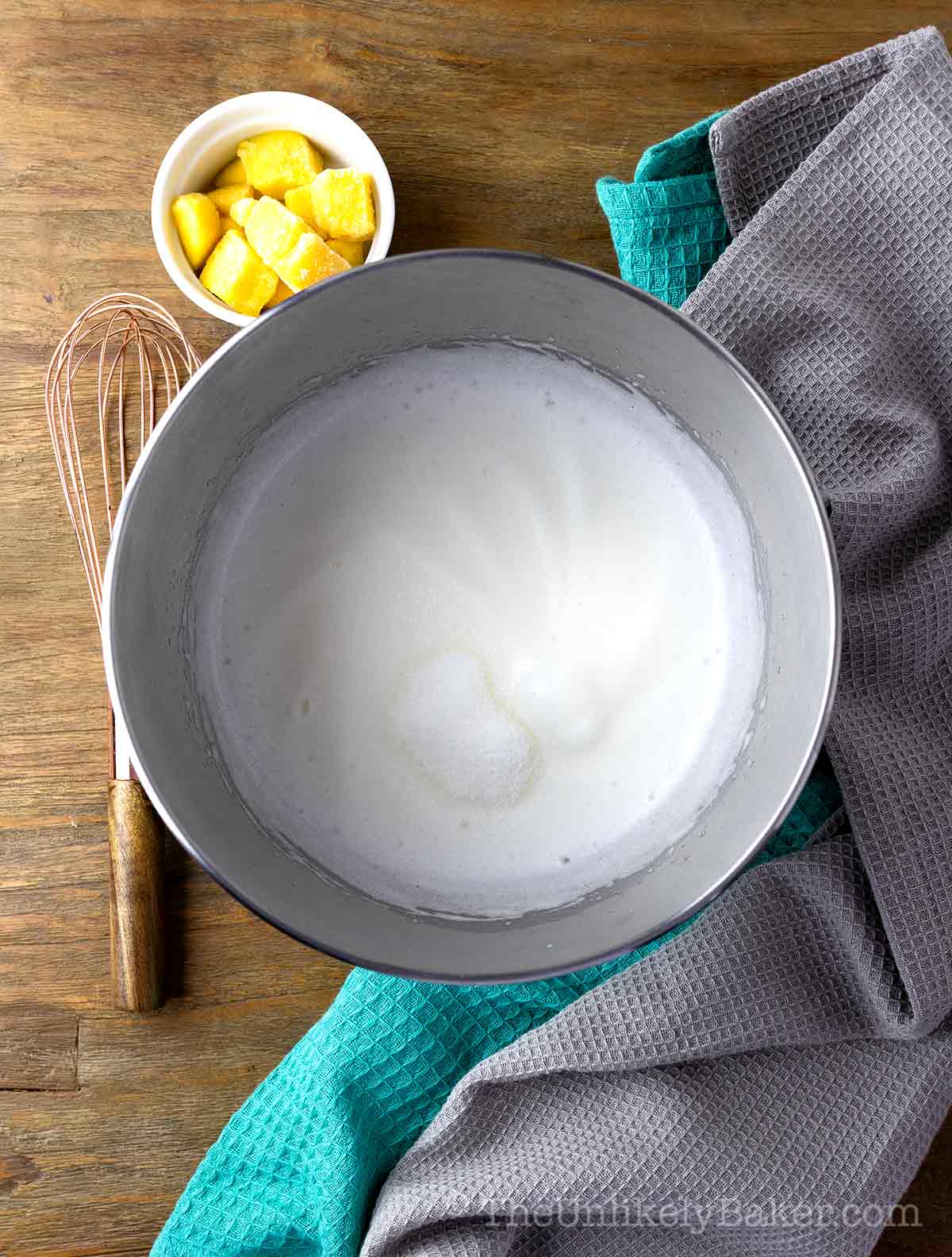
Gradually add sugar (about a teaspoon at a time).
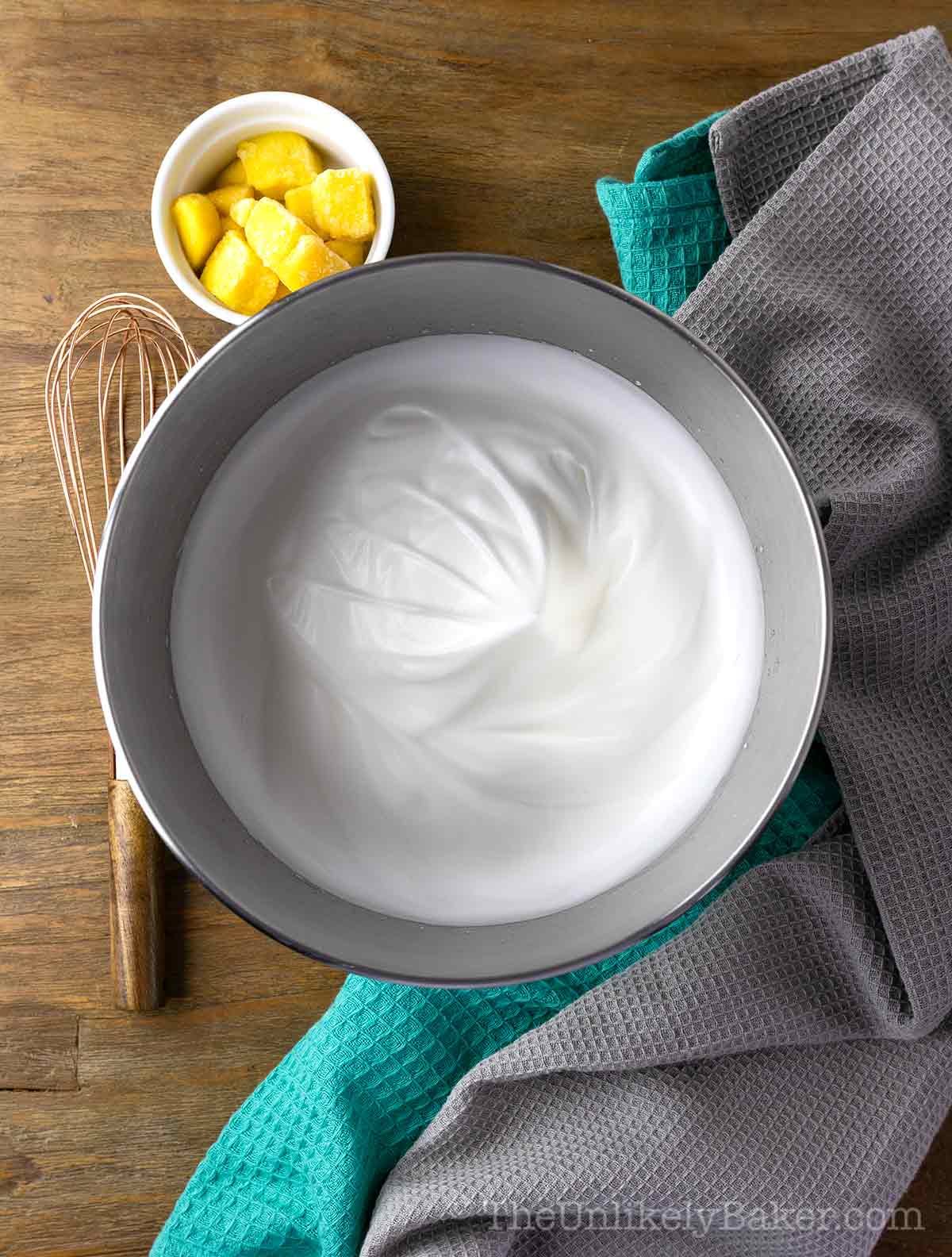
Beat until the egg whites are very stiff (about 5 minutes).
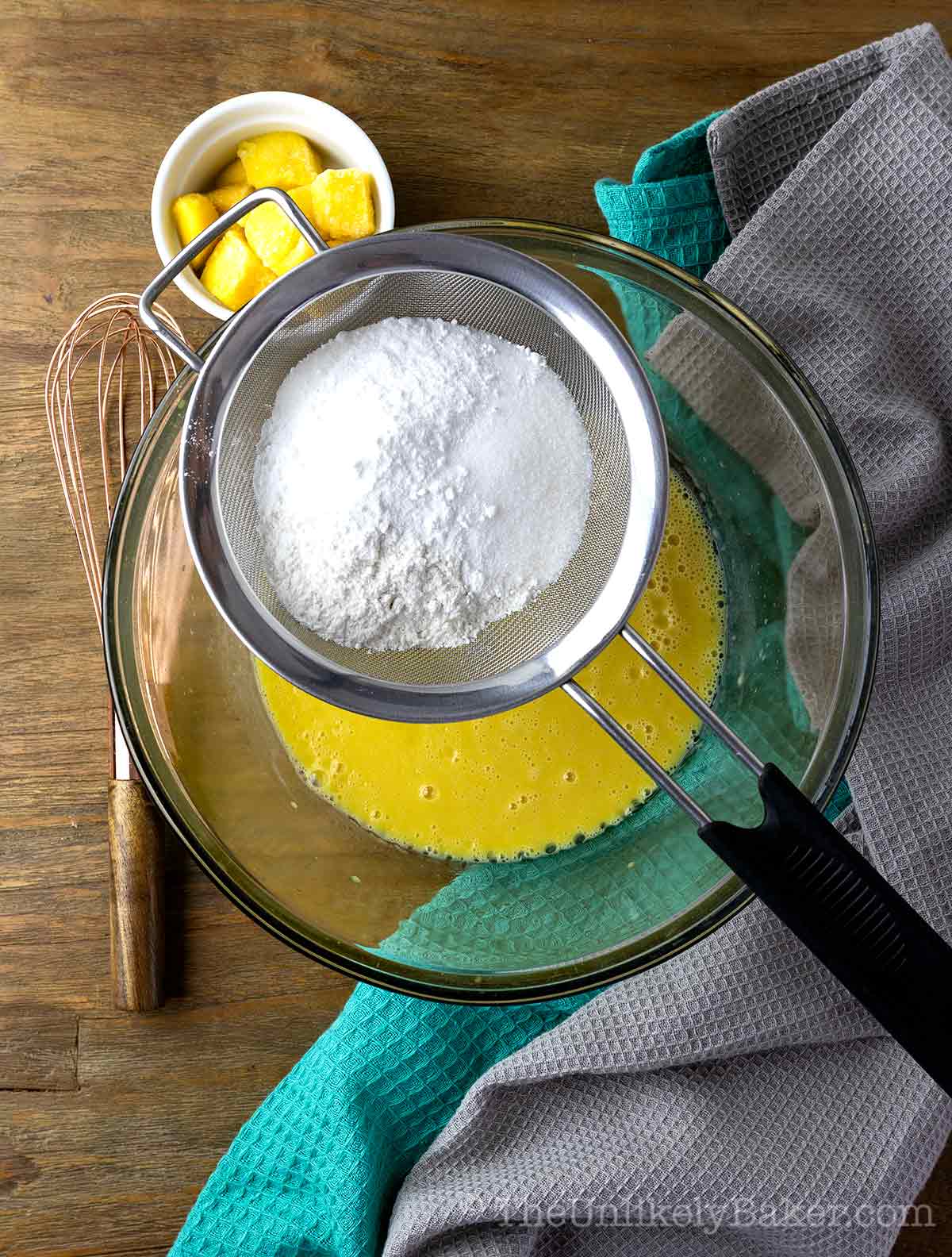
Go back to your egg yolk mixture and sift cake flour, sugar, baking powder and salt.
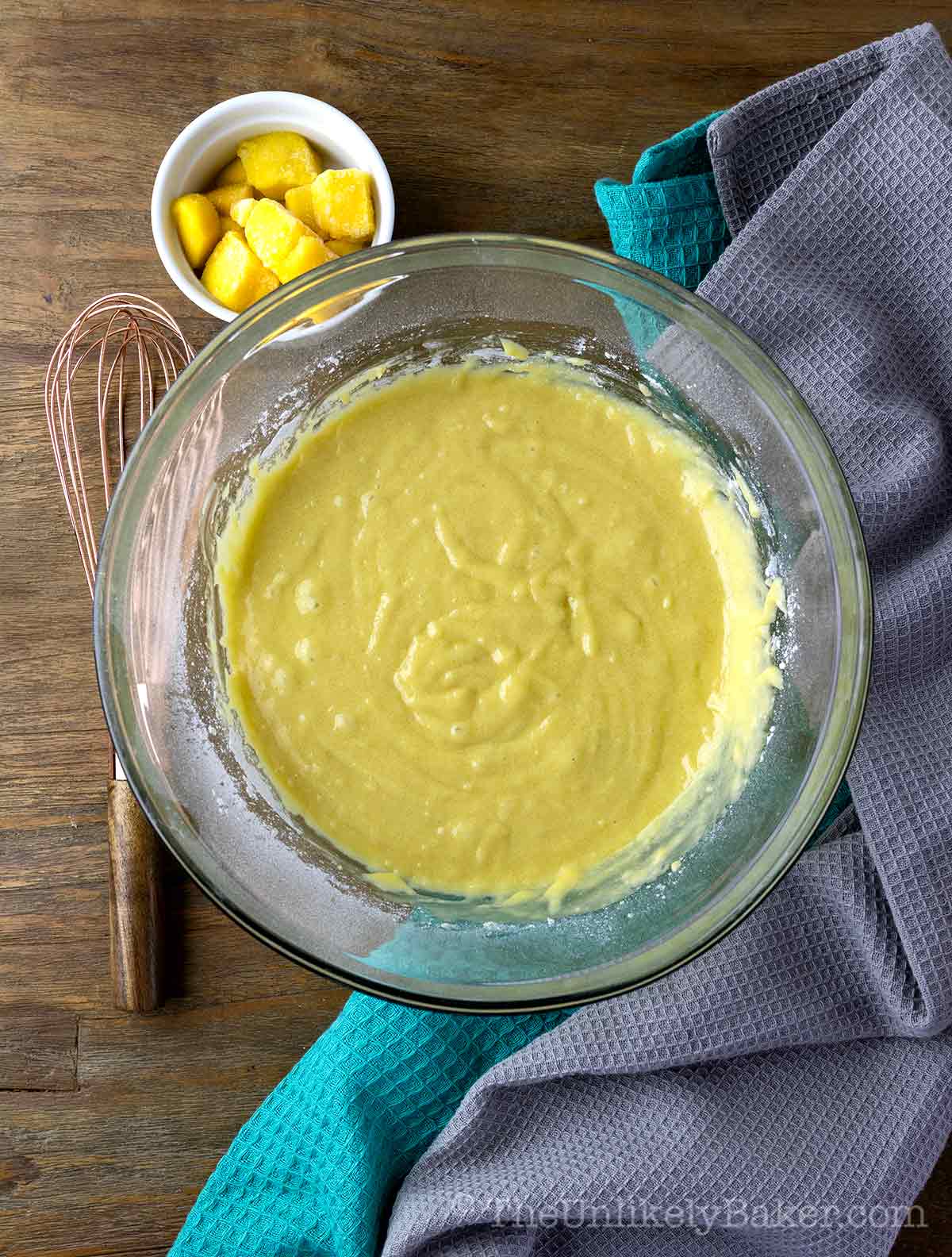
Stir until incorporated.
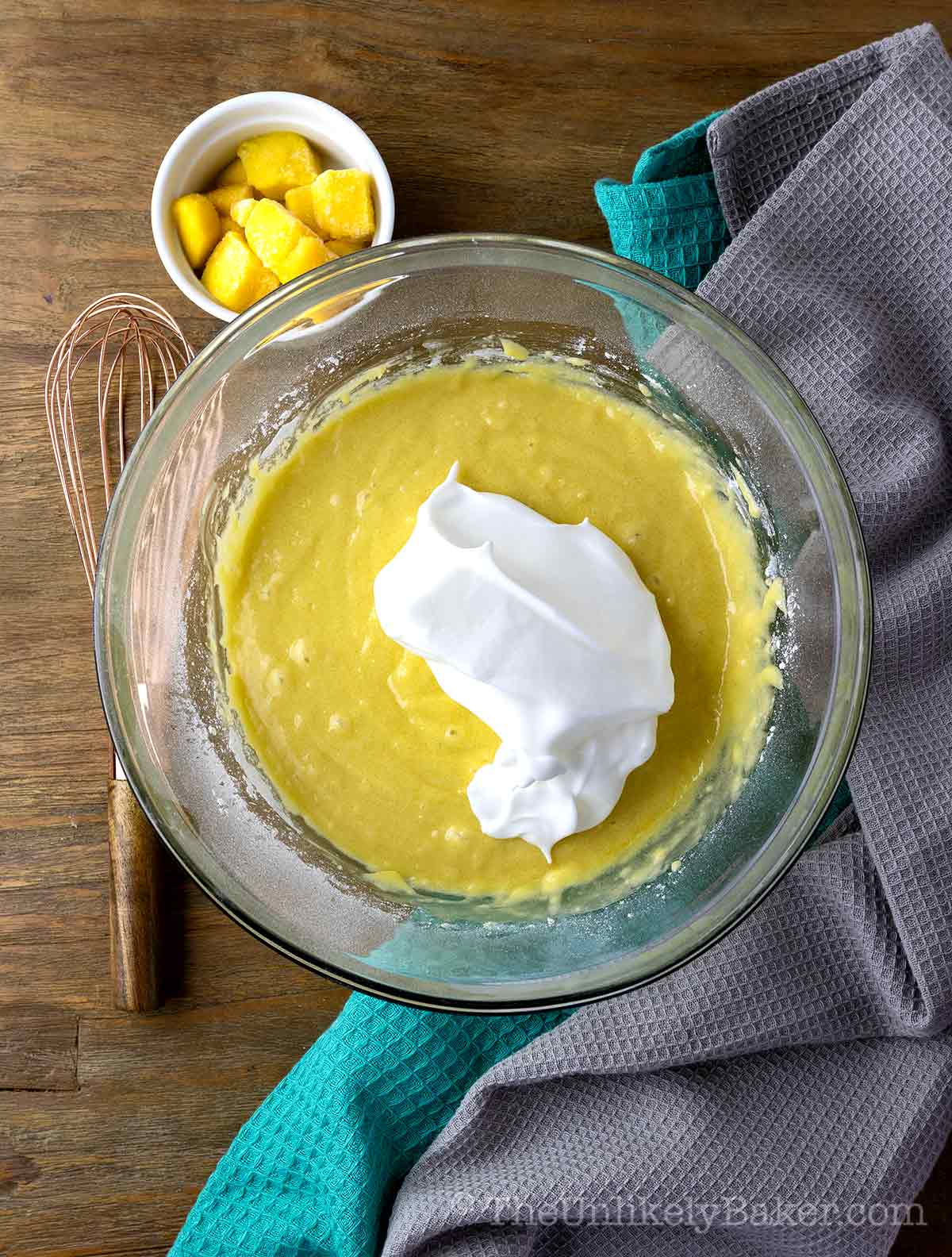
Then fold your egg whites into your batter in thirds.
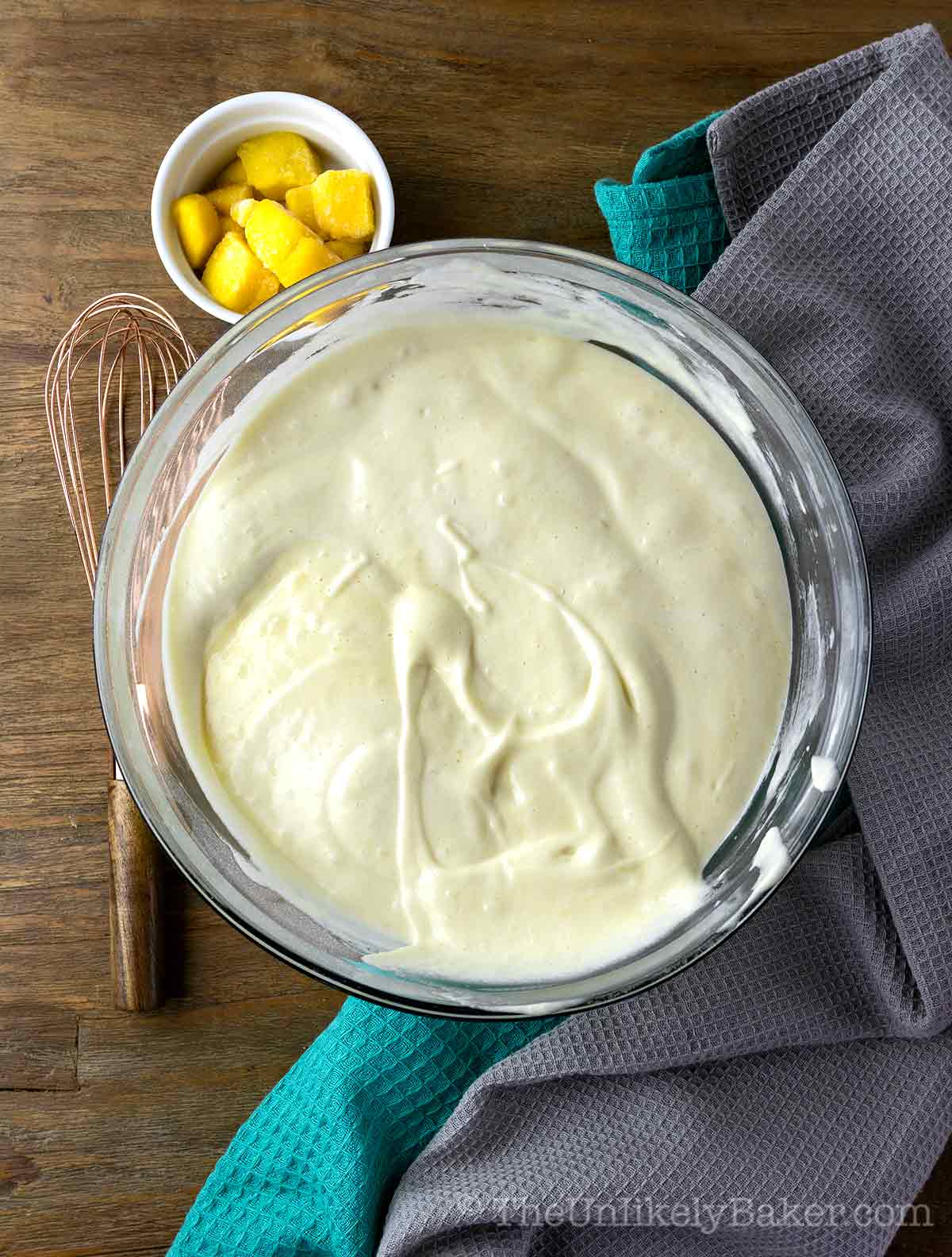
Gently fold until each addition is incorporated.
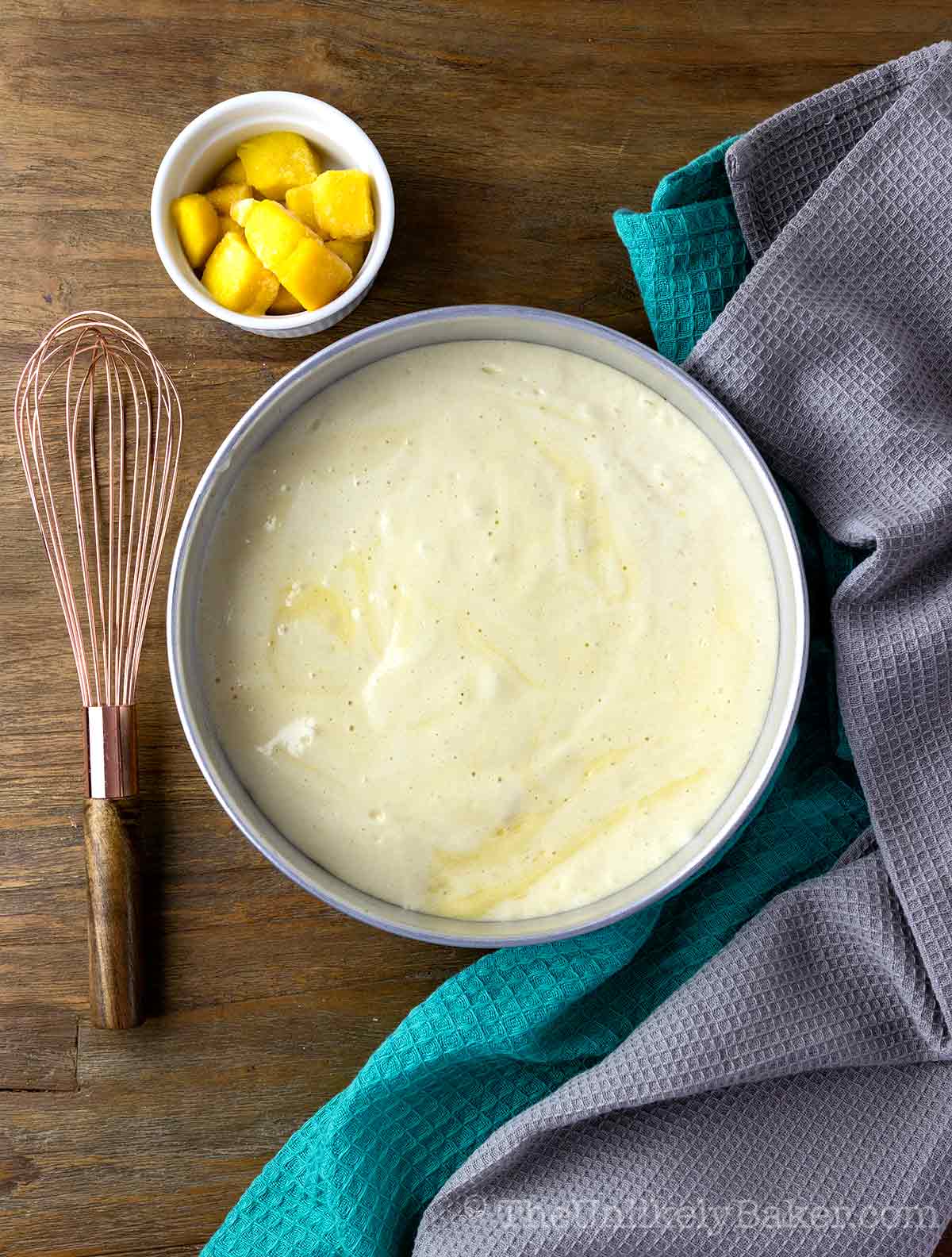
Transfer the batter equally into your 3 pans.
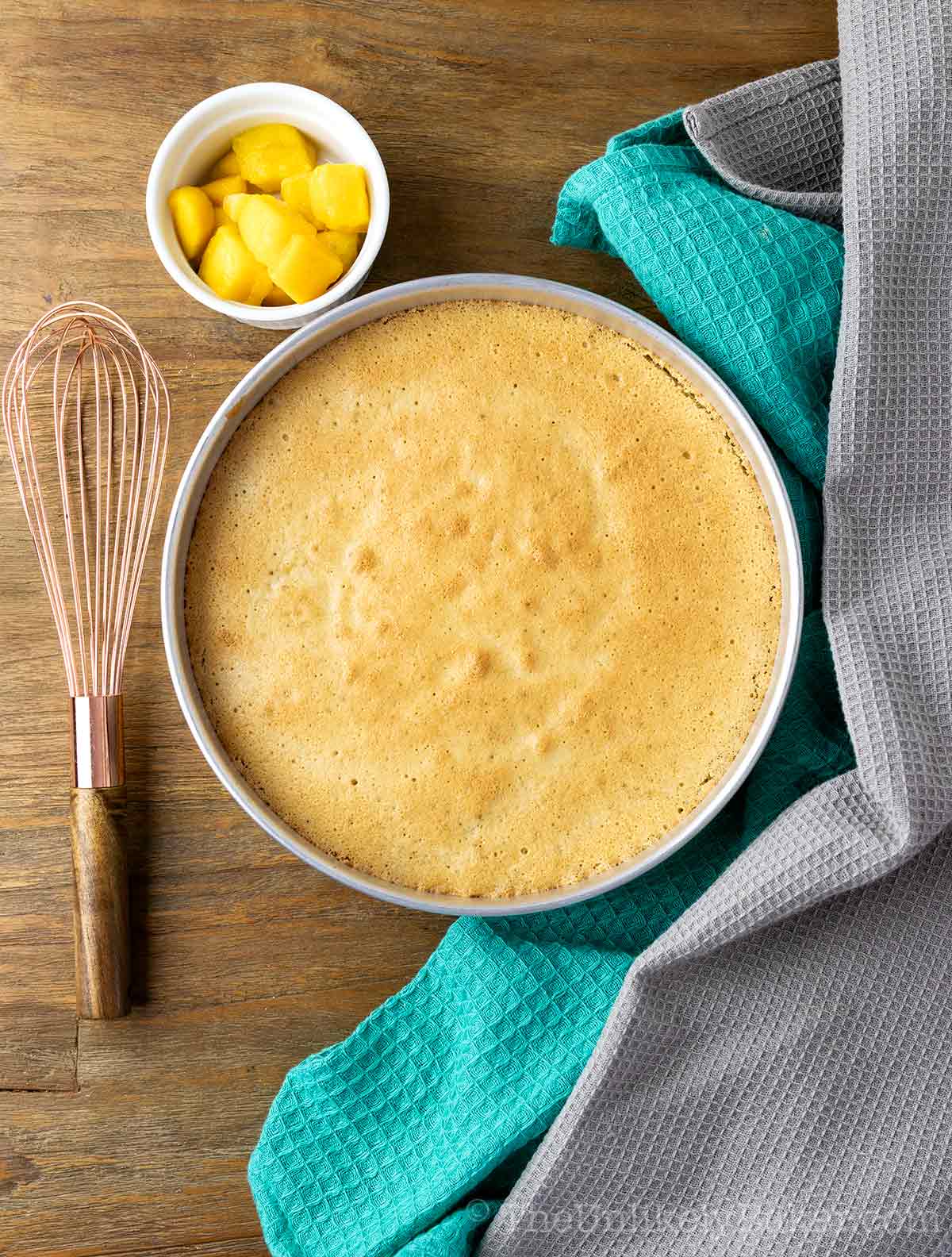
Bake for 30 minutes or until the top springs back when lightly pressed and a toothpick inserted in the center of each cake comes out clean.
Run a thin sharp knife along the sides of each cake and allow to cool in the pan for 10 minutes. Then un-mold and transfer to a wire rack to cool completely.
Mango whipped cream frosting
Pour a packet of unflavored gelatine into cold water. Do not stir. Let sit for 10 minutes to allow it to bloom.
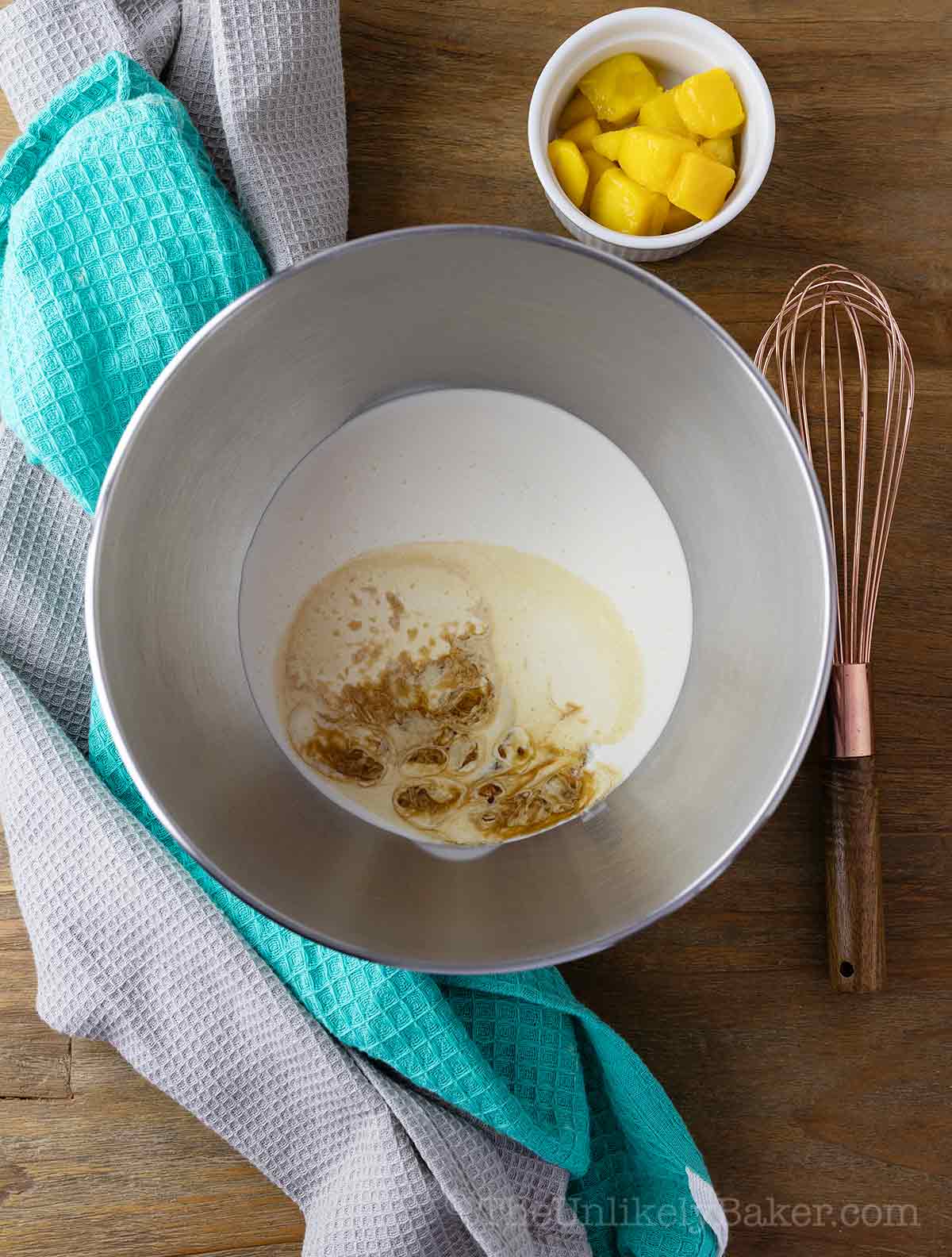
In the meantime, using a handheld electric mixer or a stand mixer fitted with the whisk attachment, whip chilled heavy cream, sugar and vanilla on medium-high speed until you reach soft peaks.
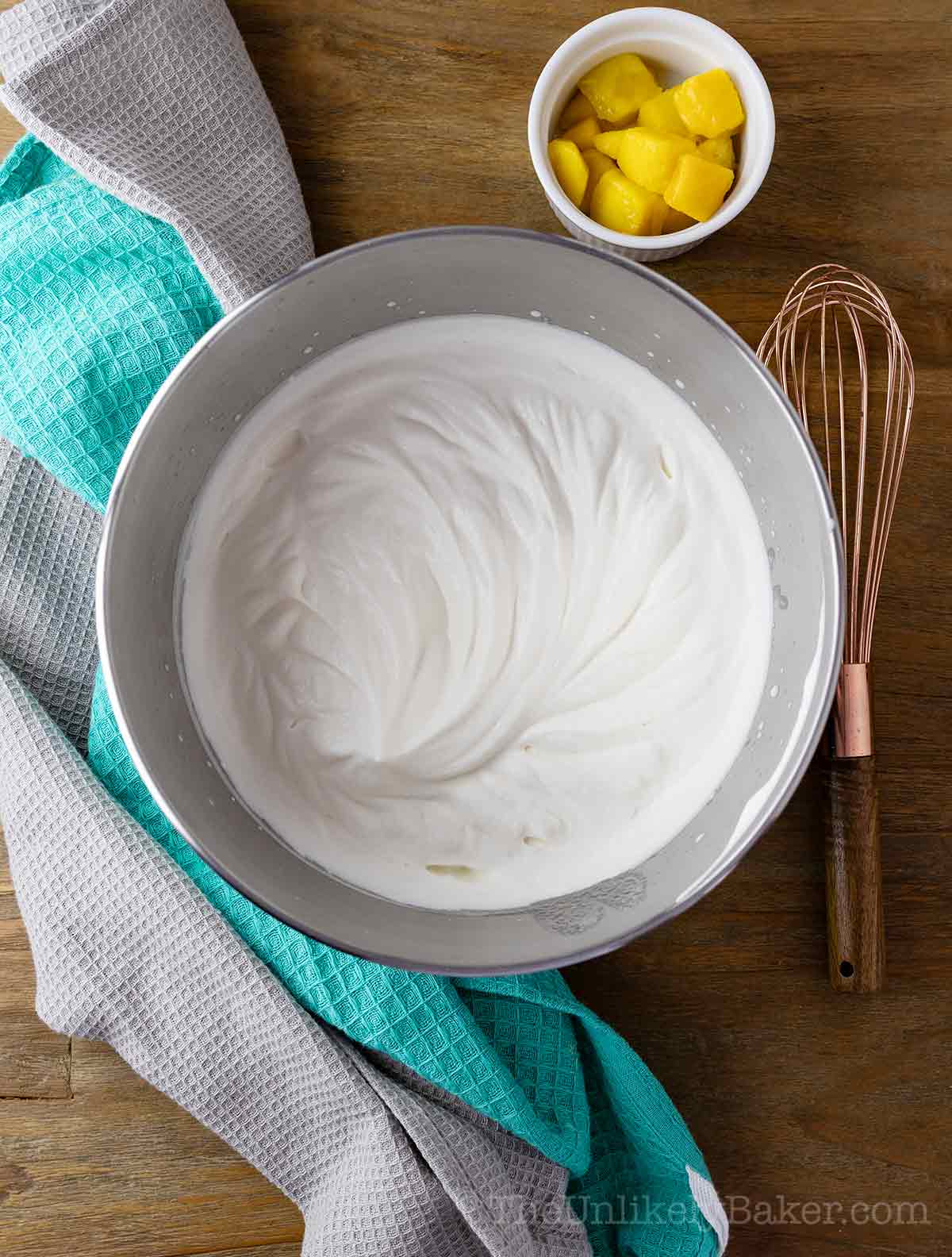
Get your gelatine and microwave for 10 seconds. Whisk until smooth (it shouldn’t be warm to the touch). With the mixer still on, gradually pour it in a steady stream into your whipped cream. Continue whipping until the gelatine is incorporated and you reach stiff peaks.
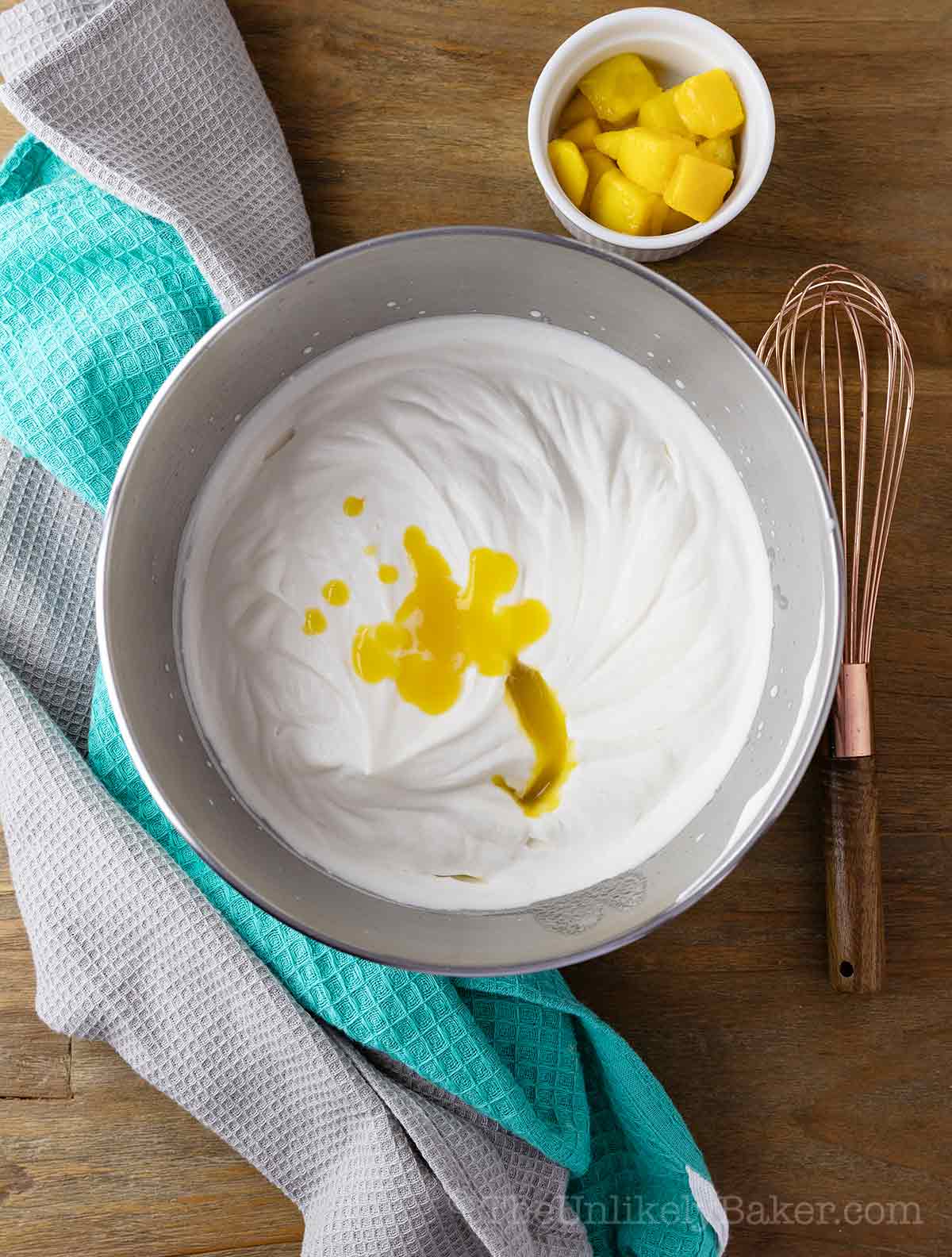
Add chilled mango puree.
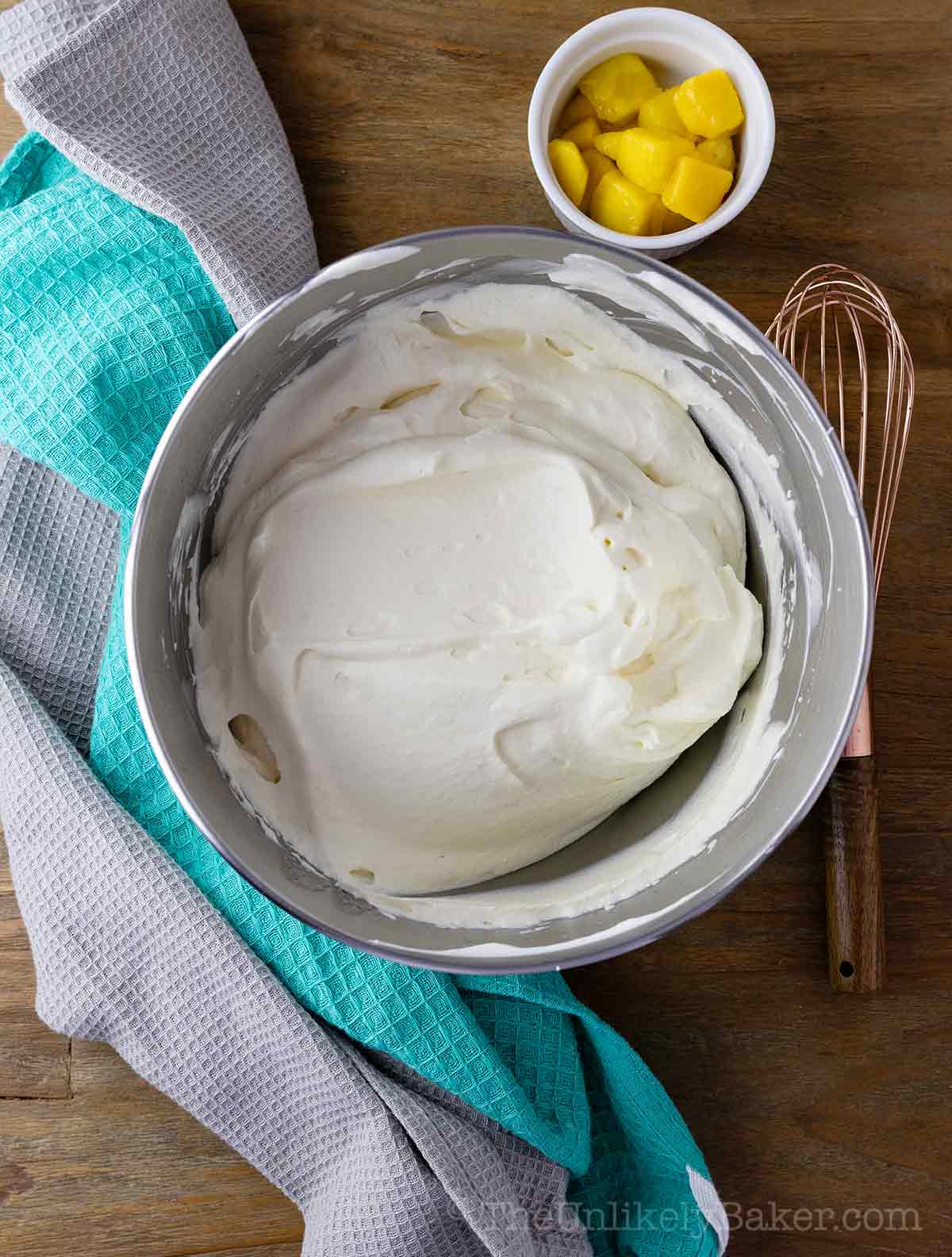
Whip until thick and creamy.
Assembly
(The layers are filled with mango curd. You also have the option fill the cake with fresh mango slices instead.)
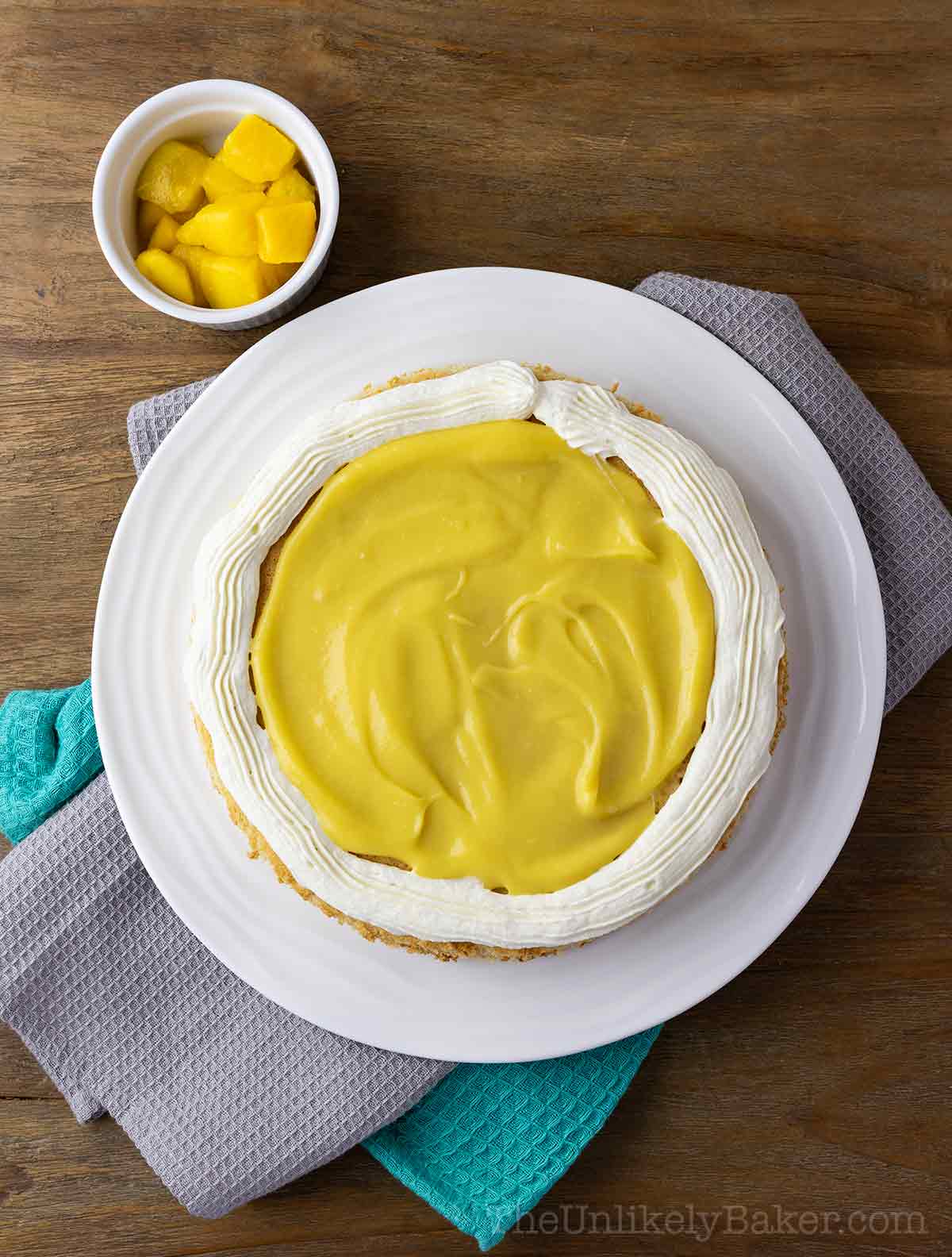
Place one cake on a platter or cake turntable smooth side down. Using a piping bag fitted with your favorite large piping tip, pipe a border around the cake to act as a dam so your mango curd won’t ooze out later. Then fill the center of your cake (inside your little dam) with mango curd. It’s important that the height of the mango curd is equal to the height of your border so that your cake doesn’t sag in the middle.

Place the other cake on top and repeat. Finally, place the third cake smooth side up, frost and decorate. Chill for at least 3 hours before serving. Enjoy!
Meringue masterclass

I’ve learned over the years that how you handle egg whites really make or break chiffon cakes — they affect not only the height but also the cake’s texture.
So I always make sure:
- Egg whites are room temperature. They whip better and result to a more stable meringue.
- But separate eggs while still cold. While you need your egg whites at room temperature, it’s easier to separate the eggs while they’re still cold. This way too, you can better avoid getting bits of egg yolks in your egg whites accidentally.
- Properly whip the egg whites stiff. You want it glossy but on the brink of turning matte.
- Everything must be grease-free. You need to make sure that your bowl and whisk are dry, clean and oil-free. So it’s better to use glass, stainless steel, or ceramic bowls because plastic has a tendency to hide traces of oil in it.
- Add sugar gradually. I do about a teaspoon at a time then allow several seconds to pass before adding again. Ideally, you want sugar to dissolve before adding the next teaspoon. A quick test would be to rub some meringue between your fingers. If you still feel significant grains of sugar in there, you should keep going.
- Stay on low-medium speed. Don’t go higher than medium speed (using my KitchenAid stand mixer, I stay on speed 3) when whipping your egg whites. It takes longer to get stiff peaks but this results to a more stable meringue that won’t significantly deflate or collapse after baking.
- Fold the egg whites into the batter. Careful not to over mix – you don’t want to deflate the egg whites and lose all the air that you managed to whip up.
(Wondering what to do with those leftover egg yolks? Check out this delicious collection of leftover egg yolk recipes.)
Troubleshooting guide
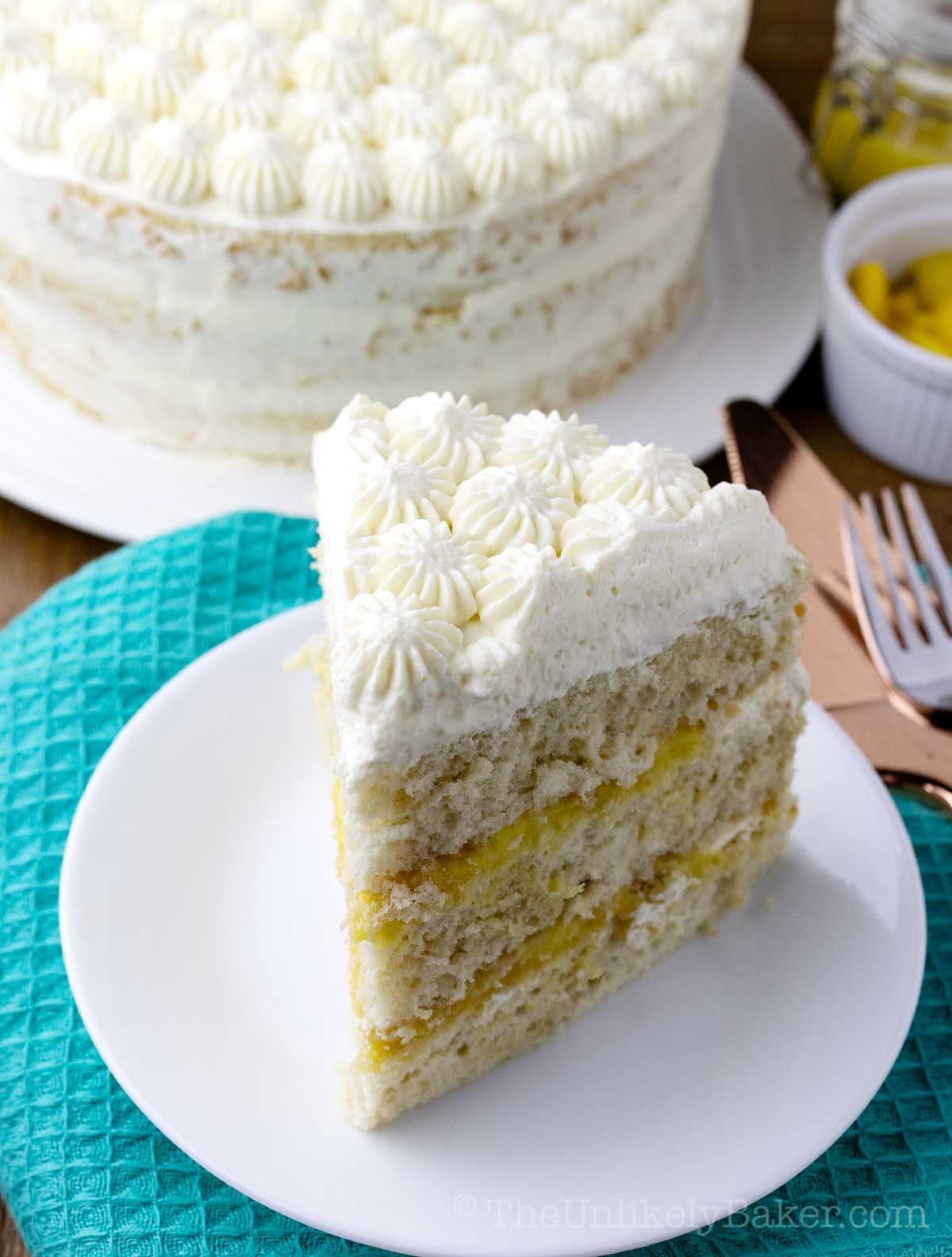
| Issue | Likely Cause/s | Possible Solution/s |
| Cakes deflated or collapsed significantly after baking | Egg whites not stable | This means air bubbles collapsed after baking. Stay on low speed and add sugar a little at a time for a more stable meringue. |
| Cakes did not rise | Oven temperature too low | If your oven temperature is too low, your cakes will not rise properly. Use an oven thermometer to make sure you’re baking at the correct temperature. |
| Pans were greased | Don’t grease the pan, especially the sides, as the cake batter needs to cling to the sides to help it rise. | |
| Cakes are dry, dense and rubbery | Batter was over-mixed | Avoid over mixing the batter because doing so results to heavy and dense cakes. |
| Cakes were over-baked | Over-baking causes cakes to lose moisture and become dry and rubbery. Check for doneness as soon as the top springs back when lightly pressed and a toothpick inserted in the center of each cake comes out clean. | |
| Oven temperature too high | Use an oven thermometer to make sure you’re baking at the correct temperature. | |
| Frosting is runny | Cream doesn’t have enough milk fat | For best results, use heavy cream (at least 36% milk far). Whipping cream (35%) will also work but will result in softer peaks. |
| Ingredients too warm | For best results, make sure your ingredients are chilled before using, as well as your whisk and bowl. |
Recipe FAQs
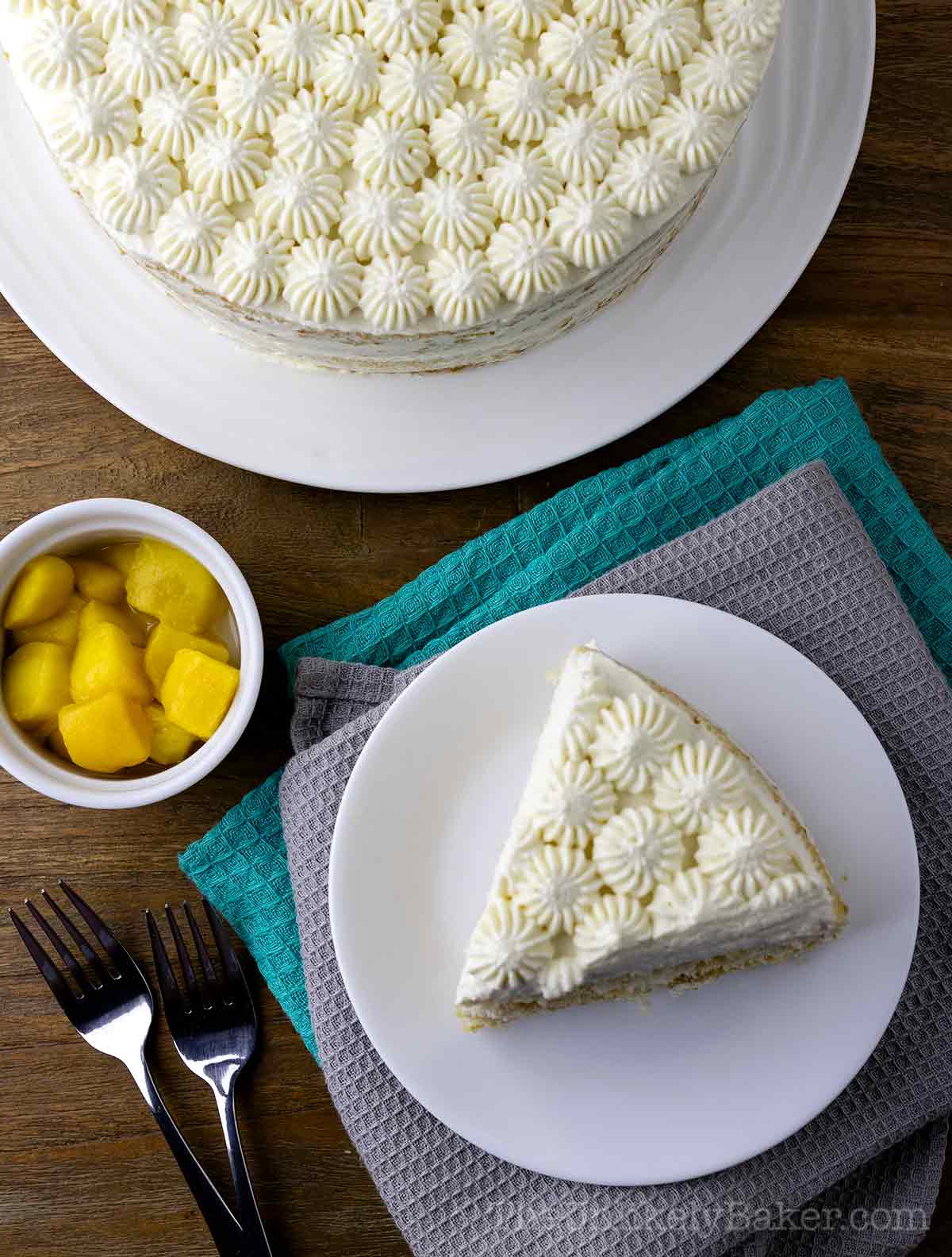
Chiffon cake is a kind of sponge cake known for its light and tender texture.
Unlike sponge cakes, which can be made with or without butter, chiffon cakes are always made with oil.
They’re also unique in that they’re leavened with egg whites beaten to stiff peaks, which is then folded into the batter, for that light and fluffy texture they are known for.
I love Philippine carabao mangoes when I can get them and here in Canada, we prefer Ataulfo mangoes.
But the answer really is whatever is available to you. Different varieties have different flavor profiles but mangoes are mangoes and they are delicious!
Some mangoes are more delicate than others though, so if you need a more intense mango flavor, you can add a few drops of mango extract.
You’ll know your chiffon cake is done baking if a toothpick inserted in the center comes out clean.
The cake should also be lightly springy to the touch. If cake batter sticks to your finger or doesn’t produce a bit of resistance, it’s not done.
Store leftover cake covered in the fridge. It should keep for up to 5 days.
While I haven’t tried freezing the frosted cake, you can choose to freeze the cake layers before assembly.
Wrap each one in plastic wrap then aluminum foil and freeze for up to 1 month. Bring down to the fridge to thaw the night before you plan on using them.
More light and airy chiffon recipes
Looking for more chiffon desserts? Check these out:
I love making this mango cake recipe. It’s refreshing, tropical, not too sweet, and so good! Mango with cream is a match made in cake heaven.
Looking for mango cream cake? Check out this reader favorite mango graham cake (mango float).
Want chiffon cheesecake? This Japanese cheesecake will satisfy your cravings.
Happy baking!
Did you make this mango chiffon cake recipe? I’d love to hear all about it! Leave a comment or a star rating below. You can also tag me on Instagram or Facebook. I’d love to see your creations!
You can also find me on Pinterest, Twitter and YouTube.
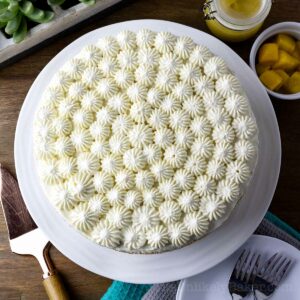
Mango Chiffon Cake with Whipped Mango Cream Frosting
Ingredients
For the Chiffon Cake:
- 5 egg yolks from large eggs room temperature
- ¾ cup mango puree room temperature
- ½ cup canola oil you can substitute any flavorless oil
- zest from 1 lemon
- 1 tsp vanilla extract
- 8 egg whites from large eggs room temperature
- ½ tsp cream of tartar
- ¼ cup granulated sugar
- 2 ¼ cups sifted cake flour
- 1 ¼ cups granulated sugar
- 1 tbsp baking powder
- 1 tsp salt
For the Whipped Mango Cream Frosting:
- 1 packet unflavored gelatine equivalent to 1 tablespoon
- ¼ cup cold water
- 2 cups heavy cream chilled
- 2 tbsp granulated sugar
- 2 tsp vanilla extract
- 1 cup mango puree chilled, see notes
Assembly:
- mango curd can substitute with fresh ripe mango slices
Instructions
For the Mango Chiffon Cake:
- Pre-heat your oven to 325F and line the bottom of 3 9-inch round pans with parchment paper. Do not grease.
- Using a handheld electric mixer or a stand mixer with the paddle attachment, beat egg yolks, mango puree, canola oil, lemon zest and vanilla on high speed until incorporated (about a minute). Set aside.5 egg yolks from large eggs, ¾ cup mango puree, ½ cup canola oil, zest from 1 lemon, 1 tsp vanilla extract

- Using a handheld electric mixer or a stand mixer with the whisk attachment (if using the same mixers, ensure they are clean, dry and grease-free), beat egg whites and cream of tartar on low-medium speed until you reach soft peaks (about 1-2 minutes).8 egg whites from large eggs, ½ tsp cream of tartar

- Gradually add sugar (about 1 teaspoon at a time) and beat until the egg whites are very stiff (about 5 minutes).¼ cup granulated sugar

- Sift cake flour, sugar, baking powder and salt into your egg yolk mixture. Stir until incorporated.2 ¼ cups sifted cake flour, 1 ¼ cups granulated sugar, 1 tbsp baking powder, 1 tsp salt

- Then fold your egg whites into your batter in thirds. Gently fold until each addition is incorporated.

- Transfer the batter equally into your 3 pans.

- Bake for 30 minutes or until the top springs back when lightly pressed and a toothpick inserted in the center of each cake comes out clean.

- Remove from oven, run a sharp knife along the sides of each cake and allow to cool in the pan for 10 minutes.
- Then unmold and transfer to a wire rack to cool completely.
For the Whipped Mango Cream Frosting:
- Pour 1 packet of unflavoured gelatine into cold water. Do not stir. Let sit for 10 minutes to allow it to bloom.1 packet unflavored gelatine, ¼ cup cold water
- In the meantime, using a handheld electric mixer or a stand mixer fitted with the whisk attachment, whip heavy cream, sugar and vanilla on medium-high speed until you reach soft peaks.2 cups heavy cream, 2 tbsp granulated sugar, 2 tsp vanilla extract

- Get your gelatine and microwave for 10 seconds. Whisk until smooth (it shouldn't be warm to the touch anymore).
- With the mixer still on, gradually pour it in a steady stream into your whipped cream.
- Continue whipping until the gelatine is incorporated and you reach stiff peaks.

- Add mango puree and whip until thick and creamy.1 cup mango puree

Assembly:
- Place one cake on a platter or cake turntable smooth side down.
- Using a piping bag fitted with your favorite large piping tip, pipe a border around the cake to act as a dam so your mango curd won’t ooze out later.

- Fill the center of your cake (inside your little dam) with mango curd. It’s important that the height of the mango curd is equal to the height of your border so that your cake doesn’t sag in the middle.mango curd
- Place the other cake on top and repeat.
- Finally, place the third cake smooth side up, frost and decorate.

- Chill for at least 3 hours before serving. Enjoy!
Video
Notes
- I usually use store-bought mango puree. You want to make sure it’s pure mango and doesn’t have added sugar or other ingredients. If using fresh ripe mangoes (or frozen mangoes), you can use your blender or food processor to puree the mango flesh then strain to remove any fibers left behind.
- I use this recipe for mango curd. You make this up to 4 weeks ahead. You can also use mango slices as filling instead.
- See post for lots of baking tips, a troubleshooting guide, FAQs and step-by-step photos.
Nutrition
Nutritional information are estimates only.

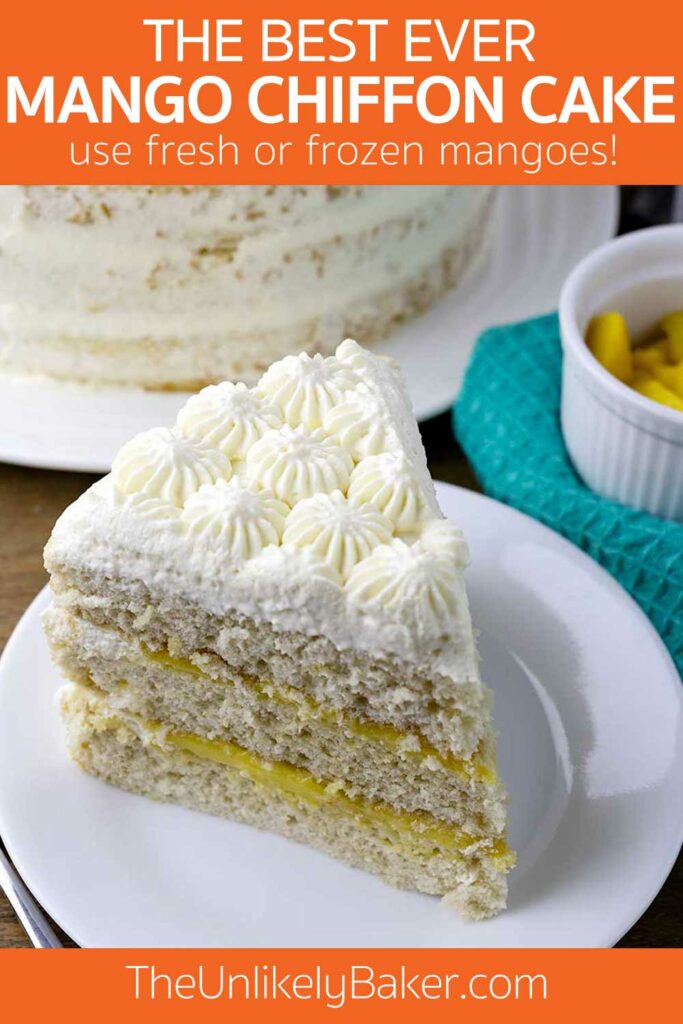

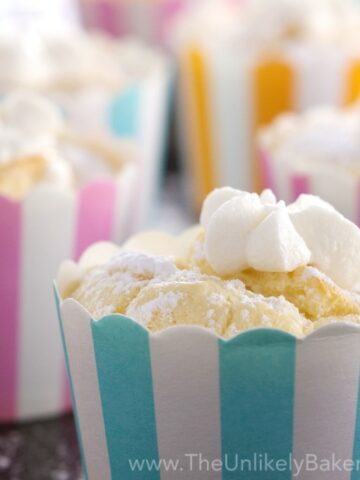

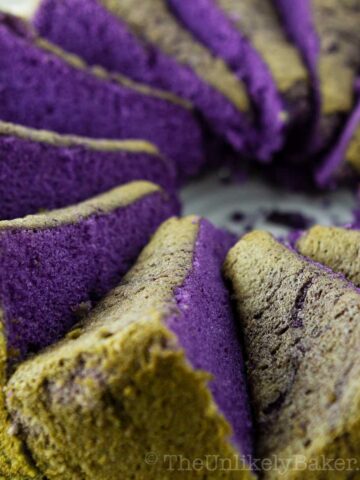
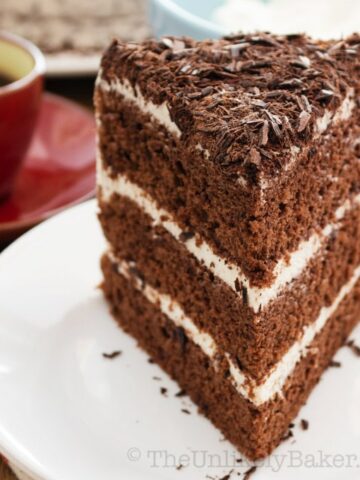
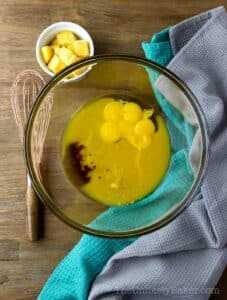
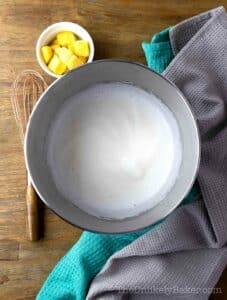
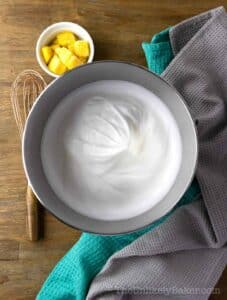
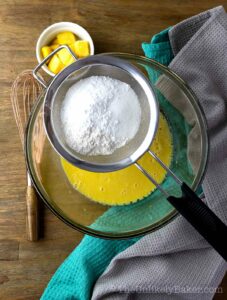
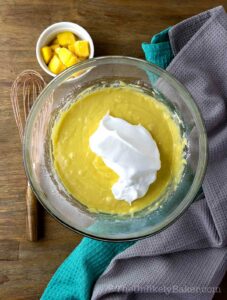
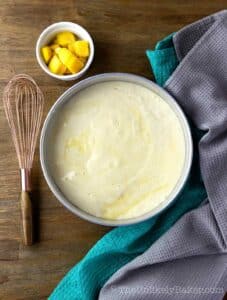
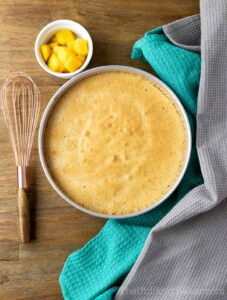
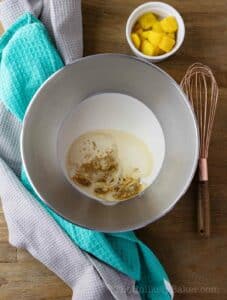
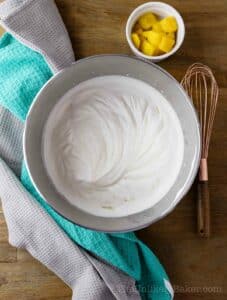
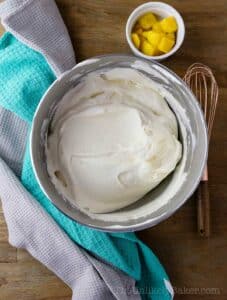
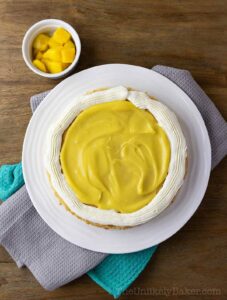
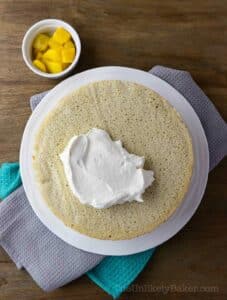
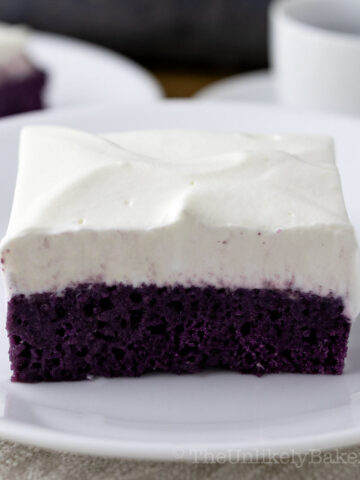
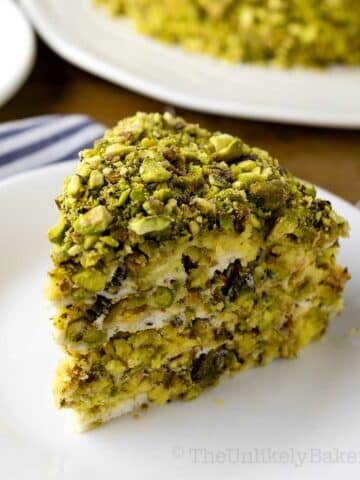
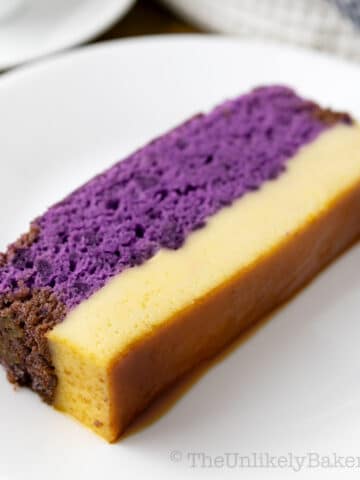
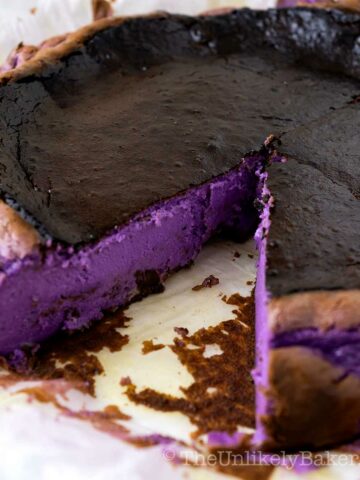
Susan Mary Malone
You are killing me! This looks so luscious. I think I might go straight to the mango butter-cream frosting tho!
Jolina
Haha I love the frosting too 🙂
Heather Johnson
I have never had mango cake before. That whipped cream frosting sounds to die for!
Catherine Sargent
This cake looks so yummy! I am always looking for new desserts to try. Thanks for the recipe!!
Jolina
My pleasure! Hope you like it.
Julia
Give me all the mango desserts! This cake looks sooooo good
Terra
Oh My! This looks amazing. I absolutely love mangoes. Thank you so much for this recipe.
Patricia @ Grab a Plate
This looks absolutely divine! I love mango and don’t used it in baked goods as often as I should! I also can’t wait to try your stabilization trick! Nice!
Jolina
Thanks Patricia! Have fun with stabilized whipped cream 🙂
Kate
This looks like a perfect summery dessert. I love mangos-yum!
Joanie @ One Dish Kitchen
What a beautiful cake. I love the chunks of mangos in between the layers of cake, such a lovely summertime dessert.
Elizabeth
Absolutely a great treat for summer. I can have this in a heartbeat.
Brianna
You had me at Mango frosting! Holy crap, I might just make that and eat it by the spoonful!
Jolina
I may or may not have done that. LOL! The frosting is wonderful if I say so myself 🙂
Kristen Kavan
I LOVE your idea for using gelatin in the frosting! I’ve never heard of this before, but its perfect for those hot days! This looks delish!
Jolina
Hi Kristen! It worked wonderfully for this cake. The frosting held up nicely. Hope you give it a go!
Dawn - Girl Heart Food
Great tip about stabilizing whipped cream – didn’t know that trick 🙂 I honestly can’t blame you for not sharing any of these beauty, Jolina! It looks too good and the mango is so perfect for summer. Next time you make this one, send me a piece will ya 😉 ?
Jolina
Hi Dawn! Haha we felt a little bad about it after to be honest! And we might have gained a few pounds too lol. It’s really become one of our favourite things now 🙂
Nicole Parise
I don’t make cakes very often, but this one looks so good for summer! Mango is always the best 🙂
Jolina
Hi Nicole! Can’t agree with you more 🙂
Maggie Unzueta
Whoooa! Mango. I’m sold.
Hannah
Oh this looks sooo good! I absolutely love cake but the mango in it would make me feel a little healthier hahaha. So delicious and I’m definitely adding this to my list of stuff to make!
Jolina
Absolutely! Mango = fruit = healthy haha! Hope you like the cake Hannah!